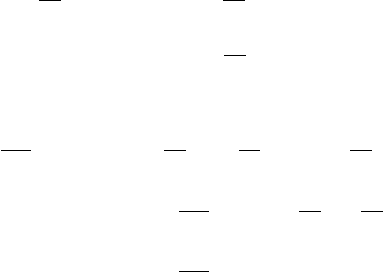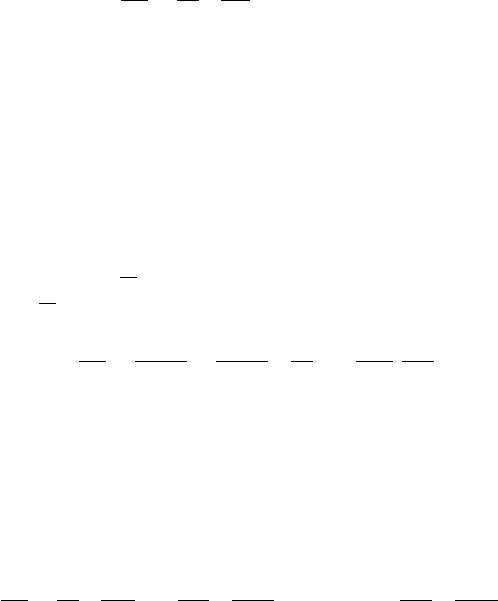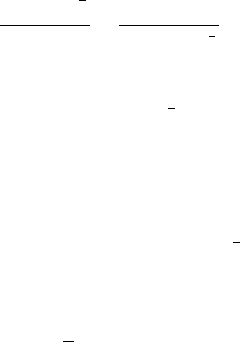Myint Tyn U., Debnath L. Linear Partial Differential Equations for Scientists and Engineers
Подождите немного. Документ загружается.


14.6 Variational Methods and the Euler–Lagrange Equations 631
A self-adjoint operator A on a Hil bert space H is said to be positive if
Au, u≥0 for all u in H, where equality implies that u =0inH. Further,
if there exists a positive constant k such that Au, u ≥k u, u for all u in
H,thenA is called positive definite in H.
The rest of this section is essentially concerned with linear operators in
a real Hilbert space, which means that the associated scalar field involved
is real. Some specific inner products which will be used in the subsequent
sections include
u, v =
b
a
u (x) v (x) dx, u, v =
D
u (x , y) v (x, y) dx dy,
where D ⊂ R
2
.
Example 14.6.4. Determine whether the differentiable operators (i) A =
d/dx, (ii) A = d
2
/dx
2
, and (iii) A = ∇
2
=
∂
2
/∂x
2
+
∂
2
/∂y
2
are self-
adjoint for functions that are differentiable in a ≤ x ≤ b or in D ⊂ R
2
and
vanish on the boundary.
(i) Au, v =
b
a
du
dx
vdx=
b
a
u
−
dv
dx
dx +[u, v]
b
a
= u, A
∗
v where A
∗
= −
d
dx
= A.
Hence, A is not self-adjoint.
(ii) Au, v =
b
a
d
2
u
dx
2
vdx=
b
a
du
dx
−
dv
dx
dx +
v
du
dx
b
a
=
b
a
u
d
2
v
dx
2
dx +
v
du
dx
− u
dv
dx
b
a
=
b
a
u
d
2
v
dx
2
dx = u, Av.
Thus, A is self-adjoi nt.
(iii) Au, v =
D
∇
2
u
vdxdy=
D
[∇·(∇u) v −∇u ·∇v] dx dy
=
∂D
(
6
n ·∇u) vdS−
D
∇u ·∇vdxdy
= −
D
(∇u ·∇v) dx dy,
where the divergence theorem is used with the unit outward normal vector
6
n.
Noting the symmetry of the right hand side in u and v, it follows that
Au, v = Av, u = u, Av.
This means th at the operator A = ∇
2
is self-adjoint.

632 14 Numerical and Approximation Methods
Example 14.6.5. Use the inn er pro d uct u, v =
***
D
(u · v) dV and the
operator A = grad to show that A
∗
= −div provided the functions vanish
on the boundary surface ∂D of D.
We use the divergence theorem to obtain
Aφ, v =
D
(grad φ · v) dV =
D
[div (φv) − φ div v] dV,
=
D
φ (−div v) dV +
∂D
(
6
n · φv) dS,
=
D
φ (−div v) dV = φ, −div v = φ, A
∗
v.
In the theory of calculus of variations it is a common practice to use δu,
δ
2
u, etc. to denote the first and second variations of a function u.Thus,δ
can be regarded as an operator that changes u into δu, u
x
into δ (u
x
), and
u
xx
into δ (u
xx
) with the meaning, δu = εv, δ (u
x
)=εv
x
, δ (u
xx
)=εv
xx
,
where ε is a small arbitrary real parameter. The operators δ, δ
2
are called
the first and second variational operators respectively.
Some simple properties of the operator δ are given by
∂
∂x
(δu)=
∂
∂x
(εv)=ε
∂v
∂x
= δ
∂u
∂x
, (14.6.1)
δ
b
a
udx
= ε
b
a
vdx=
b
a
εvdx =
b
a
(δu) dx. (14.6.2)
The variational operator can be interchanged with the differential and in-
tegral operators, and proves to be very useful in the calculation of the
variation of a functional.
The main task of the calculus of variations is concerned with the problem
of minimizing or maximizing functionals involved in mathematical, physical
and engineering p robl ems. The variational principles have their origins in
the simplest kin d of variational problem, which was first considered by Euler
in 1744 and Lagrange in 1760-61.
The classical Euler–Lagrange variational problem is to determine the
extremum value of the functional
I (u)=
b
a
F (x, u, u
′
) dx, u
′
=
du
dx
, (14.6.3)
with the boundary conditions
u (a)=α and u (b)=β, (14.6.4)
where u b elongs to the class C
2
([a, b]) of functions which have continuous
derivatives up to second-order in a ≤ x ≤ b,andF has continuous second-
order derivatives with respect to all of its arguments.

14.6 Variational Methods and the Euler–Lagrange Equations 633
We assume that I (u) has an extremum at some u ∈ C
(2)
([a, b]). Then
we consider the set of all variations u + ǫv for fix ed u where v is an arbi-
trary function belonging to C
2
([a, b]) such that v (a)=v (b)=0.Wenext
consider the increment of the functional
δI = I (u + εv) − I (u)=
b
a
[F (x, u + εv,u
′
+ εv
′
) − F (x, u, u
′
)] dx.
(14.6.5)
From the Taylor series expansion
F (x, u + εv,u
′
+ εv
′
)=F (x, u, u
′
)+ε
v
∂F
∂u
+ v
′
∂F
∂u
′
+
ε
2
2!
v
∂F
∂u
+ v
′
∂F
∂u
′
2
+ ··· ,
it follows from (14.6.5) that
I (u + εv)=I (u)+εδI +
ε
2
2!
δ
2
I + ··· , (14.6.6)
where the first and second variations of I are given by
δI =
b
a
v
∂F
∂u
+ v
′
∂F
∂u
′
dx, (14.6.7)
δ
2
I =
b
a
v
∂F
∂u
+ v
′
∂F
∂u
′
2
dx. (14.6.8)
The necessary condition for the functional I (u) to have an extremum (that
is, I (u) is stationary at u) is that th e first variation becomes zero at u so
0=δI =
b
a
v
∂F
∂u
+ v
′
∂F
∂u
′
dx (14.6.9)
which is, by partial integration of the second integral,
=
b
a
∂F
∂u
−
d
dx
∂F
∂u
′
vdx+
v
∂F
∂u
′
b
a
.
Because v (a)=v (b) = 0, this means that
b
a
∂F
∂u
−
d
dx
∂F
∂u
′
vdx=0. (14.6.10)
Since v is arbitrary in a ≤ x ≤ b, it follows from (14.6.10) that
∂F
∂u
−
d
dx
∂F
∂u
′
=0. (14.6.11)
This is the famous Euler–Lagrange equation. We therefore can state:

634 14 Numerical and Approximation Methods
Theorem 14.6.1. A necessary condition for the functional I (u) to be sta-
tionary at u is that u is a solution of the Euler–Lagrange equation
∂F
∂u
−
d
dx
∂F
∂u
′
=0,a≤ x ≤ b (14.6.12)
with
u (a)=α, u (b)=β. (14.6.13)
This is called the Euler–Lagrange variational principle.
Note that, in general, equation (14.6.12) is a nonlinear second-order
ordinary differential equations, and, although such an equation is very dif-
ficult to solve, still it seems to be more accessible analytically than the
functional (14.6.3) from which it is derived.
The derivative
d
dx
in (14.6.12) can be computed by recalling u = u (x)
and u
′
=
du
dx
, and equation (14.6.12) becomes
∂F
∂u
−
∂
2
F
∂x∂u
′
−
∂
2
F
∂u∂u
′
du
dx
−
∂
2
F
∂u
′2
d
2
u
∂x
2
=0.
It is left to the reader to verify that the functional with one independent
variable and nth-order derivatives in the for m
I (u)=
b
a
F (x, u, u
x
,u
xx
,...,u
x
n
,...,) dx
admits the Euler–Lagrange equation
∂F
∂u
−
d
dx
∂F
∂u
x
+
d
2
dx
2
∂F
∂u
xx
− ...(−1)
n
d
n
dx
n
∂
2
F
∂u
x
n
=0.
After we have determined the f unction u which makes I (u) stationary,
the question of the nature of the extremu m arises, that is, its minimum,
maximum, or saddle point properties. To answer this question, we look at
the second variation defined in (14.6.8). If terms of O
ε
3
can be neglected
in (14.6.6), or if they vanish for the case of quadratic F, it follows from
(14.6.6) that a necessary condition for the functional I (u)tohaveamini-
mum I (u) ≥ I (u
0
)atu = u
0
is that δ
2
I ≥ 0, for I (u) to have a maximum
I (u) ≤ I (u
0
)atu = u
0
is that δ
2
I ≤ 0atu = u
0
respectively for all
admissible values of v. These results enable us to determine the upper or
lower bounds for the stationary value I (u
0
) of the functional.
Example 14.6.6. Find out the shortest distance between given points A and
B in the (x, y)-plane.
Suppose APB is any curve in the plane through A and B,ands =
arcAP . The problem is to determine the curve for which the functional

14.6 Variational Methods and the Euler–Lagrange Equations 635
I (y)=
B
A
ds, (14.6.14)
is a minimum.
Since ds/dx =
1+y
′2
1
2
, functional (14.6.14) becomes
I (y)=
x
2
x
1
1+y
′2
1
2
dx. (14.6.15)
In this case, F =
1+y
′2
1
2
which depends on y
′
only, so ∂F/∂y =0.
Hence, the Euler–Lagrange equation (14.6.12) becomes
d
dx
∂F
∂y
′
=0.
This gives the differential equation
y
′′
=0. (14.6.16)
This means that the curvature for all points on the curve AB is zero. Hence,
the path AB is a straight line. It follows from the integration of (14.6.16)
that y = mx + c is a two-parameter family of straight lines.
Example 14.6.7. (Fermat principle in optics). In an optically homogeneous
isotro-pic medium, light travels from one point A to another point B along
thepathforwhichthetraveltimeisminimum.
The velocity of light v is the same at all points of the medium; hence, the
minimum time is equivalent to the minimum path length. For simplicity,
consider a path joining the two points A and B in the (x, y)-plane. The
time to travel an elementary arc length ds is ds/v. Thus, the variational
problem is to find the path for which
B
A
ds
v
=
x
2
x
1
1+y
′2
1
2
dx
v
=
x
2
x
1
F (y, y
′
) dx (14.6.17)
is a minimum, where y
′
= dy/dx,andv = v (y).
When F is a function of y and y
′
, the Euler–Lagrange equation (14.6.12)
becomes
d
dx
(F − y
′
F
y
′
)=0. (14.6.18)
This follows from the result
d
dx
(F − y
′
F
y
′
)=
d
dx
F (y, y
′
) − y
′′
F
y
′
− y
′
d
dx
(F
y
′
)
= y
′
F
y
+ y
′′
F
y
− y
′′
F
y
− y
′
d
dx
(F
y
′
)
= y
′
F
y
−
d
dx
(F
y
′
)
=0, by (14.6.12) .

636 14 Numerical and Approximation Methods
Hence,
F − y
′
F
y
′
= constant, (14.6.19)
or
1+y
′2
1
2
v
−
y
′2
v (1 + y
′2
)
1
2
= constant,
or
v
−1
1+y
′2
−
1
2
= constant. (14.6.20)
In order to give a simple physical interpretation, we rewrite (14.6.20) in
terms of th e angle φ made by the tangent to the minimum path with the
vertical y-axis so that
sin φ =
1+y
′2
−
1
2
.
Hence,
1
v
sin φ = constant = K (14.6.21)
for all points on the minimum curve. For a ray of light, (1/v)mustbe
directly proportional to the refractive index n of the medium through which
light is travelling. Equation (14.6.21) is called the Snell law of refraction of
light. Often this law is stated as
n sin φ = constant. (14.6.22)
(A) Hamilton Pr inciple
The difference between the kinetic energy T and the potential energy V
of a dynamical system is denoted by L = T − V . The quantity L is called
the Lagrangian of the system. The Hamilton principle states that the first
variation of the time integral of L is zero, that is,
δ
t
2
t
1
Ldt= δ
t
2
t
1
(T − V ) dt =0. (14.6.23)
This result is supposed to be valid for all dynamical systems whether they
are conservative or nonconservative.
For a conservative system the force fi eld F = −∇V and T + V = C,
where C is a constant, and so (14.6.23) gives the principle of least action
δA =0,A=
t
2
t
1
Ldt, (14.6.24)
where A is called the action integral or simply the action of the system.

14.6 Variational Methods and the Euler–Lagrange Equations 637
Example 14.6.8. Derive the Newton second law of motion from the Hamil-
ton principle.
Consider a particle of mass m at the position r =(x, y, z)whichis
moving under the action of a field of force F. The kinetic energy of the
particle is T =
1
2
m
˙
r
2
, and the variation of work done is δW = F · δr and
δV = −δW. Thus, th e Hamilton principle for the system is
0=δ
t
2
t
1
(T − V ) dt =
t
2
t
1
(δT −δV ) dt =
t
2
t
1
(m
˙
r · δ
˙
r + F · δr) dt.
Integrating this result by parts and noting that δr vanishes at t = t
1
and t = t
2
, we obtain
t
2
t
1
(m
¨
r − F) · δr dt =0.
This is true for every virtual displacement δr, and hence, the integrand
must vanish, that is,
m
¨
r = F. (14.6.25)
This is the celebrated Newton second law of motion.
Example 14.6.9. Derive the equation for a simple harmonic oscillator in a
non-resisting medium from the Hamilton principle.
For a simple harmonic oscillator, T =
1
2
m ˙x
2
and V =
1
2
mω
2
x
2
. Accord-
ing to the Hamilton principle
δ
t
2
t
1
1
2
m ˙x
2
−
1
2
mω
2
x
2
dt = δ
t
2
t
1
F (x, ˙x) dt =0.
This leads to the Euler–Lagrange equation
∂F
∂x
−
d
dt
(m ˙x)=0,
or
¨x + ω
2
x =0. (14.6.26)
This is the equation for the simple harmonic oscillator.
Example 14.6.10. A straight uniform elastic beam of length l, line density ρ,
cross-sectional moment of inertia I, and modulus of elasticity E is fixed at
each end. The beam performs small transverse oscillations in the horizontal
(x, y)-plane. Derive the equation of motion of the beam.
The potential energy of the elastic beam is
V =
1
2
l
0
M
2
EI
dx =
1
2
l
0
EIy
′′2
dx,

638 14 Numerical and Approximation Methods
where the bending moment M is proportional to the curvature so that
M = EI
y
′′
(1 + y
′2
)
1
2
∼ EI y
′′
for small y
′
.
The variational principle gives
δ
t
2
t
1
(T − V ) dt = δ
t
2
t
1
F (y
′′
, ˙y) dt =0,
where
F (y
′′
, ˙y)=
1
2
l
0
ρ ˙y
2
− EI y
′′2
dx.
This principle leads to the Euler–Lagrange equation
−
l
0
ρ¨y + EIy
(iv)
dx =0,
or
ρ¨y + EIy
(iv)
=0. (14.6.27)
This represents the partial differential equation of the transverse vibration
of the beam.
(B) The Generalized Coordinates, Lagrange Equation, and
Hamilton Equation
The Euler–Lagrange analysis of a dynamical system can be extended to
more complex cases where the configuration of the system is described by
generalized coordinates q
1
, q
2
, ..., q
n
. Without loss of generality, we consider
a system of three variables where the familiar Cartesian coordinates x, y,
z can be expressed in terms of the generalized coordinates q
1
, q
2
, q
3
as
x = x (q
1
,q
2
,q
3
) ,y= y (q
1
,q
2
,q
3
) ,z= z (q
1
,q
2
,q
3
) . (14.6.28)
For example, if (q
1
,q
2
,q
3
) represents the cylindrical polar coordinates
(r, θ, z), the above result becomes
x = r cos θ, y = r sin θ, z = z.
Since the coordinates are functions of time t, we obtain the following
result by differentiation
˙x =
∂x
∂q
1
˙q
1
+
∂x
∂q
2
˙q
2
+
∂x
∂q
3
˙q
3
(14.6.29)

14.6 Variational Methods and the Euler–Lagrange Equations 639
with similar expressions for ˙y and ˙z.
If these results are substituted into T =
1
2
m
˙x
2
+˙y
2
+˙z
2
and V =
V (x, y, z), then both T and V can be written in terms of the generalized
coordinates q
i
and the generalized velocities ˙q
i
,as
T = T (q
1
,q
2
,q
3
;˙q
1
, ˙q
2
, ˙q
3
) ,V= V (q
1
,q
2
,q
3
) , (14.6.30)
so that the Lagrangian has the form
L = T − V = L (q
i
, ˙q
i
) . (14.6.31)
The Hamilton principle gives
δ
t
2
t
1
L (q
i
, ˙q
i
) dt =0. (14.6.32)
The simple variation of this integral with fixed end points, the inter-
change of the variation operations and time derivatives f or the variation of
the generalized velocities, and then integration by parts yield
t
2
t
1
3
i=1
∂L
∂q
i
−
d
dt
∂L
∂ ˙q
i
δq
i
dt =0, (14.6.33)
where the integrated components vanish because of the conditions δq
i
=0
(i =1, 2, 3) at t = t
1
and t = t
2
.
When the generalized coordinates are independent and the variations
δq
i
are independent for all t in (t
1
,t
2
), the coefficients of the variations δq
i
vanish independently for arbitrary values of t
1
and t
2
. This means that the
integrand in (14.6.33) vanishes, that is,
d
dt
∂L
∂ ˙q
i
−
∂L
∂q
i
=0,i=1, 2, 3. (14.6.34)
These are called the Lagrange equations of motion.
If a particle of mass m at position r =(x
1
,x
2
,x
3
) moves under the
action of a conservative force field F
i
= −∂V/∂x
i
, the Lagrangian function
is
L = T − V =
1
2
m
˙x
2
1
+˙x
2
2
+˙x
2
3
− V (x
1
,x
2
,x
3
) . (14.6.35)
Consequently,
∂L
∂ ˙x
i
= m ˙x
i
,
∂L
∂x
i
= −
∂V
∂x
i
= F
i
. (14.6.36)
The former represents the momentum of the particle and the latter is the
force acting on the particle. In view of (14.6.36), the Lagrange equation
(14.6.34) gives the Newton second law of motion in the form
d
dt
(m ˙x
i
)=F
i
. (14.6.37)

640 14 Numerical and Approximation Methods
Example 14.6.11. Apply the Lagrange equations of motion to derive the
equations of motion of a particle under the action of a central force,
−mF (r)wherer is the distance of the particle of mass m from the center
of force.
It is convenient to use the polar coordinates r and θ. In terms of the
generalized coordinates q
1
= r and q
2
= θ,wewrite
x = r cos θ = q
1
cos q
2
,y= r sin θ = q
1
sin q
2
.
The kinetic energy T is
T =
1
2
m
˙x
2
+˙y
2
=
1
2
m
˙r
2
+ r
2
˙
θ
2
=
1
2
m
˙q
2
1
+ q
2
1
˙q
2
2
. (14.6.38)
Since F = ∇V ,thepotentialis
V (r)=
r
F (r) dr =
q
1
F (q
1
) dq
1
. (14.6.39)
Then, the Lagrangian L is
L = T − V =
1
2
m
˙q
2
1
+ q
2
1
˙q
2
2
− 2
q
1
F (q
1
) dq
1
. (14.6.40)
Thus, the Lagrange equations (14.6.34) wit h i = 1, 2, 3 give the equations
of motion
¨q
1
− q
1
˙q
2
2
+ F (q
1
)=0,
d
dt
q
2
1
˙q
2
=0. (14.6.41)
In term of the polar coordinates, these equations become
¨r − r
˙
θ
2
= −F (r) ,
d
dt
r
2
˙
θ
=0. (14.6.42ab)
Equation (14.6.42b) gives immediately
r
2
˙
θ = h, (14.6.43)
where h is a constant. In this case, r
˙
θ represents the transverse velocity
component, and mr
2
˙
θ = mh is the constant angular momentum of the
particle about the center of force.
Introducing r =1/u, we obtain
˙r =
dr
dt
= −
1
u
2
du
dt
= −
1
u
2
du
dθ
·
dθ
dt
= −h
du
dθ
,
¨r =
d
2
r
dt
2
= −h
d
dt
du
dθ
= −h
d
2
u
dθ
2
dθ
dt
= −h
2
u
2
d
2
u
dθ
2
.
Substituting these into (14.6.42a) gives
